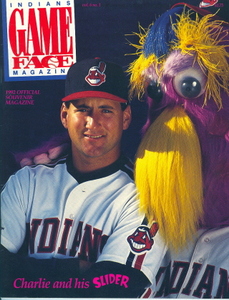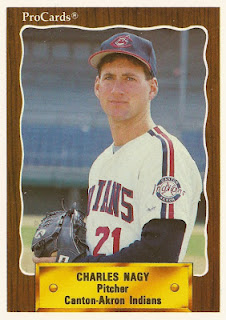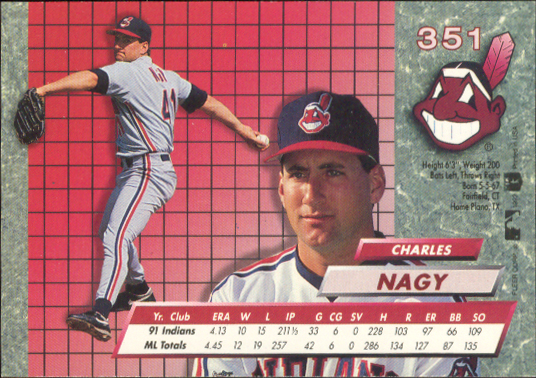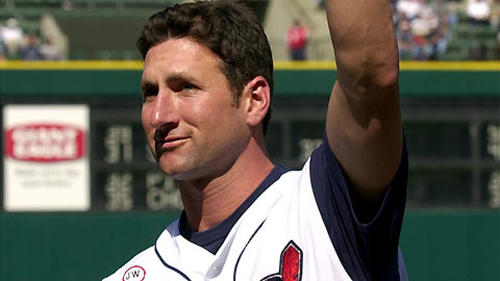 Indians Archive
Indians Archive  Tribe Game Vault: 8/8/92. Tribe Ace Charles Nagy’s No-Hit Bid
Tribe Game Vault: 8/8/92. Tribe Ace Charles Nagy’s No-Hit Bid
 I get teased about almost always being upbeat about the Indians. There’s always a light at the end of the tunnel (and no, it’s not an oncoming train).
I get teased about almost always being upbeat about the Indians. There’s always a light at the end of the tunnel (and no, it’s not an oncoming train).
But today? Adam Burke’s Cleveland Fan article on the Tribe’s ‘deafening silence’ said it all. You could have made a case for the team bolstering the big league roster at the deadline; likewise, you could posit that they should have gotten a head start on a realistic window of contention. They could have gotten a nice return of prospects for productive veterans such as closer Chris Perez.
But they did nothing. That does not mean they couldn’t make such moves this offseason, but the resulting empty feeling had me thinking about laying into the team with a truly snarky piece this week. As I seldom wish to dwell on the truly tragic or depressing, I was inclined toward focusing on the home game that sported the lowest official attendance that I could find. Because if this franchise thought it had public relations problems before, I shudder to think what might happen to ticket sales now and into 2013 (any potential, unconfirmed interest in a post-nonwaiver-deadline deal for Omar Vizquel notwithstanding).
As Indians single-game attendance futility is not easily researched, I zeroed in on some crappy Tribe seasons to see ‘how low can you go.’ I started with 1985. A bad season. I noted a game that had a paid attendance figure of 3051. Think that number was padded, to get it over 3000? Uh, maybe. I guess there wasn’t a whole lot of excitement generated by Tribe starter Keith Creel that day. Even with fudged numbers, however, I was certain I could break the 3000 barrier. I moved on to some early 1970s seasons- there were games in 1973 that drew an announced 3000+. A game that caught my eye featured starter Gaylord Perry, the reigning Indians Cy Young Award winner who’d generated excitement in 1972 with an historic winning streak. My audible gasp turned the heads of my Olympics-watching wife, and kids, and the family dog. I noted the paid attendance that night was 1437. Now, we’re getting somewhere. And, I am certain those handfuls of fans had no problem booing the home team, either (I am looking directly at your shallow, arrogant self, Perez).
The thrill of the hunt took over. 1973’s home opener drew 74,000+. Of course it did. The season proceeded to feature several games with the attendance in the 3000s, the 2000s… the onnnne… thouuuusssannnnndssss…
And there it was. Wednesday, September 19, 1973. A rare weekday afternoon game against the equally woeful Milwaukee Brewers. Paid attendance: 1009. Certainly, this game had been a true three-digit draw. Awesome. With a steady hand and a discerning eye, I moved into the box score and the play-by-play of that game.
But it was blah. Tribe starter Dick Tidrow gave up a bunch of runs early and lasted six innings. Nobody of any interest at all to Indians fans populated the Brewers roster. The Tribe was down a bunch early, scored some late, and lost 7-4. Eh. We can turn to last night's recap for that.
But man, 1009. “You know, Greg, they were terrible, and it was late in the yea-“
1009.
“But the weather might have been ba-“
1009.
“Greg, you just admitted there was nobody of interest on the Brewer-“
One thousand, nine. Seriously?
I can just picture an accountant-type in the front office at the Stadium that day, with one of those green eyeshade visors on, hurrying past Tribe GM Phil Seghi while holding a strip of adding machine tape. Seghi was an old-school baseball executive, which is code for: domineering, know-it-all spinmeister. I can see Seghi removing the pipe from his mouth and shouting, “Bean counter! Hold on. How many paid today?”
“Eight hundred and sixty two.”
Dismissively closing his eyes and shaking his head, then with a self-satisfied smile: “One thousand… and niiiiine.”
Maybe I’m not cut out for the snarky stuff. Or, more likely, my wife is right: “Greg, you need to remember that a lot of things that are funny to you are not to anyone else.” (Now, that is funny.)
So I’ll stick with the plan- we’ll stay upbeat. Because with Tribe history, there have been rough stretches, but there does exist a treasure trove of great stories buried all through the century-plus.
***
1992 saw the emergence of the Indians from one of those “darkest hours before the dawn” eras. The 1991 team had lost a franchise-record 105 games, and veterans were being jettisoned as the 1990s “Era of Champions” was ramping up. Famously, GM John Hart was signing young players such as Carlos  Baerga, Albert Belle, Kenny Lofton and Paul Sorrento to long contracts- committing salary guarantees in return for the players’ giving up free agency. The ‘Gateway’ project was proceeding, and the new ballpark at the corner of Carnegie and Ontario promised to attract free agents and fans alike.
Baerga, Albert Belle, Kenny Lofton and Paul Sorrento to long contracts- committing salary guarantees in return for the players’ giving up free agency. The ‘Gateway’ project was proceeding, and the new ballpark at the corner of Carnegie and Ontario promised to attract free agents and fans alike.
The 1992 team started slowly, with a 14 – 30 record into May. The Tribe’s fortunes turned as the season progressed, with the future looking quite bright. They began gaining confidence and winning games by the time August arrived.
On Saturday, August 8, the Indians were putting a three game winning streak on the line, at Baltimore’s beautiful, new Camden Yards ballpark. Tribe ace Charles Nagy- another young player whom Hart had signed- took the mound to face O’s starter Arthur Rhodes. The young Rhodes had been a July call-up from AAA Rochester.
Indians SS Mark Lewis got the action started with a one-out, ground rule double near the left field foul pole. With two out, menacing young Albert Belle crushed a double to left, scoring Lewis. (Belle was fresh off his three-game suspension for charging Kansas City pitcher Neil Heaton on May 4.) Rhodes struck out three in the inning. (Since he faced more than the three hitters he K’d, he did not strike out the side.) The early run was a welcome change; in Nagy’s 7 losses to this point in the season, he’d only enjoyed a total of 10 runs of support. After ½ inning, 1-0 Tribe.
Nagy lost O’s leadoff hitter and LF Brady Anderson on a 3-1 pitch. After CF Mike Devereaux popped out to Indians 1B Carlos Martinez, Anderson stole second. Nagy whiffed SS Cal Ripken and 1B Glenn Davis. After 1, 1-0 Tribe.
Nagy struck out two more hitters in the 2nd inning. He was not- nor was he ever- overpowering, but he was effectively mixing his pitches and changing speeds. The slider was his calling card.
In the top of the 3rd, CF Thomas Howard clobbered a one-out double to right-center. After Lewis moved the runner with a ground out, Baerga homered to left,  his 16th. And Belle homered to left, his 21st. Martinez spoiled the extra-base-hit parade with a line drive single before Rhodes struck out LF Glenallen Hill. Middle of the 3rd, 4-0 Tribe.
his 16th. And Belle homered to left, his 21st. Martinez spoiled the extra-base-hit parade with a line drive single before Rhodes struck out LF Glenallen Hill. Middle of the 3rd, 4-0 Tribe.
Nagy was in control, not allowing a hit through 4. Devereaux had ripped a shot up the middle that Lewis tracked down, in one of those plays that make you wonder: will everyone will be talking about that play if this indeed is a no-hitter?
Lewis cracked a home run to left center on a 1-0 pitch to lead off the 5th. Baerga struck out, and Belle walked. Baltimore manager Johnny Oates brought Todd Frohwirth on in relief to face Martinez, who singled on a ground ball. Hill also singled, loading the bases. (Frohwirth was late covering on the grounder to first.) RF Mark Whiten grounded out to first, scoring Belle, before 3B Brook Jacoby struck out to end the threat. Middle of the 5th, 6-0 Tribe.
Nagy retired the Orioles in order in the 5th, and worked around a walk in the 6th. Still no hits. After 6, 6-0 Tribe.
In the home half of the 7th, Ripken offered at the 1-0 pitch, grounding out to third. Davis worked the count to 2-1, and hit a grounder to short. Mark Lewis, however, had been playing Davis up the middle. He scooped the ball and fired to first, but Davis clearly beat the throw. The no-hitter was over, on an infield single. Nagy then induced DH Sam Horn to ground into an inning-ending double play. After 7, 6-0 Tribe.
That was pretty much it. In the 9th, the Indians hit the ball on the nose against O’s reliever Pat Clements. They had one walk and four line drives; unfortunately, only two of the liners were hits as the other two resulted in three outs.
Nagy finished with 112 pitches. He walked two and struck out seven in running his record to 12-7.
Oh, and he allowed one hit. During the game, someone in the Tribe dugout must have uttered the term, "no-hitter".
Nagy had a very nice game, and a very nice career.
I do love a positive Indians story.
Thank you for reading.

- NBA Announces 2013-2014 Schedule
- Browns Ink Sharknado
- Sharknado A No-Show For Rookie Camp
- Trent Richardson Out Until Training Camp
- Browns Sign Brandon Jackson
- Carrasco Suspended Eight Games
- Browns Add to Wide Receiver Depth with David Nelson
- Browns Need to Learn from Past Draft Mistakes
- Browns Release Chris Gocong and Usama Young
- Browns Missing on Grimes Disappointing, But Not The End
The TCF Forums
- Chris Grant's first 3 drafts
Kingpin74 (Tuesday, January 21 2014 10:13 AM) - The 2014 Offseason Thread
googleeph2 (Tuesday, January 21 2014 9:36 AM) - 2015 Recruiting
furls (Tuesday, January 21 2014 6:57 AM) - Mike Brown
YahooFanChicago (Monday, January 20 2014 11:15 PM) - Movies coming out
HoodooMan (Monday, January 20 2014 9:34 PM) - 2014 Hoops Hockey Hijinx
jpd1224 (Monday, January 20 2014 4:44 PM) - 2014 Recruiting
jclvd_23 (Monday, January 20 2014 2:26 PM) - Wish List - #4 Pick
Hikohadon (Monday, January 20 2014 1:26 PM) - Official- Browns Coach Search/Rumors
OldDawg (Sunday, January 19 2014 6:48 PM) - #1 overall pick Anthony Bennett
TouchEmAllTime (Sunday, January 19 2014 1:28 PM)


